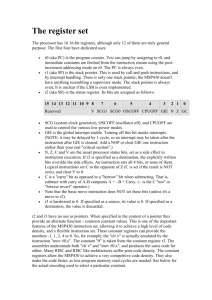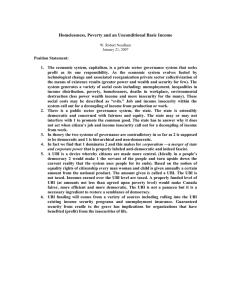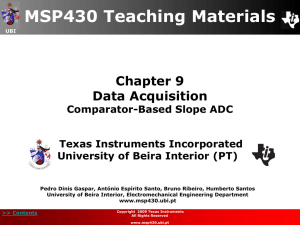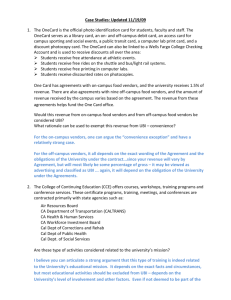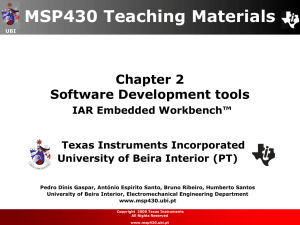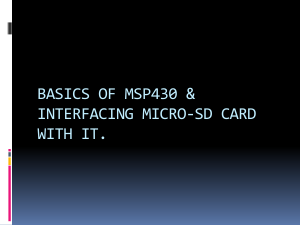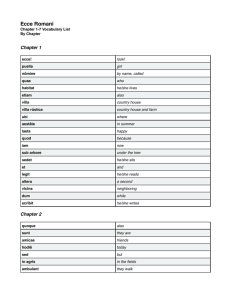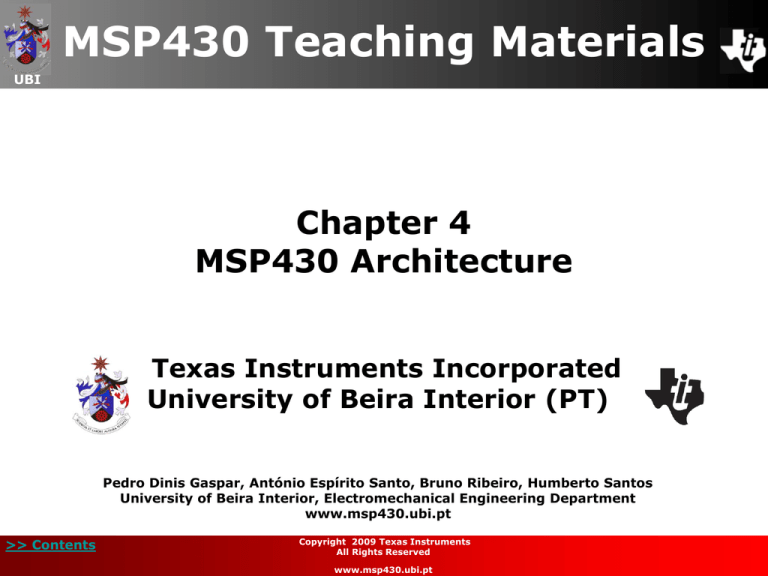
MSP430 Teaching Materials
UBI
Chapter 4
MSP430 Architecture
Texas Instruments Incorporated
University of Beira Interior (PT)
Pedro Dinis Gaspar, António Espírito Santo, Bruno Ribeiro, Humberto Santos
University of Beira Interior, Electromechanical Engineering Department
www.msp430.ubi.pt
>> Contents
Copyright 2009 Texas Instruments
All Rights Reserved
www.msp430.ubi.pt
Contents
UBI
MSP430 architecture:
Main characteristics
Architecture topology
Address space
Interrupt vector table
Central Processing Unit (MSP430 CPU)
Central Processing Unit (MSP430X CPU)
Addressing modes
Instructions set
Quiz
>> Contents
Copyright 2009 Texas Instruments
All Rights Reserved
www.msp430.ubi.pt
2
Introduction
UBI
A comprehensive description of the MSP430
architecture, covering its:
Main characteristics;
Device architecture;
Address space;
Interrupt vector table;
Central Processing Unit (MSP430 CPU and MSP430X CPU);
7 seven addressing modes and instruction set composed of:
• 27 base opcodes;
• 24 emulated instructions.
>> Contents
Copyright 2009 Texas Instruments
All Rights Reserved
www.msp430.ubi.pt
3
Microcontroller characteristics
UBI
Integration: Able to implement a whole design onto a single
chip.
Cost: Are usually low-cost devices (a few $ each);
Clock frequency: Compared with other devices
(microprocessors and DSPs), MCUs use a low clock frequency:
MCUs today run up to 100 MHz/100 MIPS (Million
Instructions Per Second).
Power consumption: Low power (battery operation);
Bits: 4 bits (older devices) to 32 bits devices;
Memory: Limited available memory, usually less than 1 MByte;
Input/Output (I/O): Low to high (8 to 150) pin-out count.
>> Contents
Copyright 2009 Texas Instruments
All Rights Reserved
www.msp430.ubi.pt
4
MSP430 main characteristics (1/3)
UBI
Low power consumption:
0.1 A for RAM data retention;
0.8 A for real-time clock mode operation;
250 A/MIPS during active operation.
Low operation voltage (from 1.8 V to 3.6 V);
< 1 s clock start-up;
< 50 nA port leakage;
Zero-power Brown-Out Reset (BOR).
>> Contents
Copyright 2009 Texas Instruments
All Rights Reserved
www.msp430.ubi.pt
5
MSP430 main characteristics (2/3)
UBI
On-chip analogue features:
10/12/16-bit Analogue-to-Digital Converter (ADC);
12-bit dual Digital-to-Analogue Converter (DAC);
Comparator-gated timers;
Operational Amplifiers (Op Amps);
Supply Voltage Supervisor (SVS).
16 bit RISC CPU:
Compact core design reduces power consumption and cost;
16-bit data bus;
27 core instructions;
7 addressing modes;
Extensive vectored-interrupt capability.
>> Contents
Copyright 2009 Texas Instruments
All Rights Reserved
www.msp430.ubi.pt
6
MSP430 main characteristics (3/3)
UBI
Flexibility:
Up to 256 kByte Flash;
Up to 100 pins;
USART, I2C, Timers;
LCD driver;
Embedded emulation;
And many more peripherals modules…
Microcontroller performance:
Instruction processing on either bits, bytes or words
Reduced instructions set;
Compiler efficient;
Wide range of peripherals;
Flexible clock system.
>> Contents
Copyright 2009 Texas Instruments
All Rights Reserved
www.msp430.ubi.pt
7
MSP430 Architecture
UBI
Block diagram:
>> Contents
Copyright 2009 Texas Instruments
All Rights Reserved
www.msp430.ubi.pt
8
Address Space
UBI
Mapped into a single, contiguous address space:
All memory, including RAM, Flash/ROM, information
memory, special function registers (SFRs), and peripheral
registers.
Memory Map:
Memory Address
End:
0FFFFh
Start:
0FFE0h
End:
0FFDFh
Flash/ROM
Start *:
End *:
Start:
End:
Start:
End *:
Start:
End:
Start:
End:
Start:
End:
Start:
>> Contents
Description
Interrupt Vector Table
0F800h
01100h
010FFh
0107Fh
01000h
0FFFh
0C00h
09FFh
027Fh
0200h
01FFh
0100h
00FFh
0010h
000Fh
0000h
Word/Byte
Word/Byte
Information Memory
(Flash devices only)
Boot Memory
(Flash devices only)
Word/Byte
RAM
Word/Byte
Word/Byte
16-bit Peripheral modules
Word
8-bit Peripheral modules
Byte
Special Function Registers
Byte
Copyright 2009 Texas Instruments
All Rights Reserved
www.msp430.ubi.pt
Access
9
Interrupt vector table
UBI
Mapped at the very end of memory space (upper 16
words of Flash/ROM): 0FFE0h - 0FFFEh (4xx devices);
Priority of the interrupt vector increases with the word
address.
>> Contents
Copyright 2009 Texas Instruments
All Rights Reserved
www.msp430.ubi.pt
10
Central Processing Unit (MSP430 CPU)
(1/7)
UBI
RISC (Reduced Instructions Set Computing)
architecture:
Instructions are reduced to the basic ones (short set):
• 27 physical instructions;
• 24 emulated instructions.
This provides simpler and faster instruction decoding;
Interconnect by a using a common memory address bus
(MAB) and memory data bus (MDB) - Von Neumann
architecture:
• Makes use of only one storage structure for data and
instructions sets.
• The separation of the storage processing unit is implicit;
• Instructions are treated as data (programmable).
>> Contents
Copyright 2009 Texas Instruments
All Rights Reserved
www.msp430.ubi.pt
11
UBI
Central Processing Unit (MSP430 CPU)
(2/7)
RISC (Reduced Instructions Set Computing) type
architecture:
Uses a 3-stage instruction pipeline containing:
• Instruction decoding;
• 16 bit ALU;
• 4 dedicated-use registers;
• 12 working registers.
Address bus has 16 bit so it can address 65 kB (including
RAM + Flash + Registers);
Arithmetic Logic Unit (ALU):
Addition, subtraction, comparison and logical (AND, OR,
XOR) operations;
Operations can affect the overflow, zero, negative, and carry
flags of the SR (Status Register).
>> Contents
Copyright 2009 Texas Instruments
All Rights Reserved
www.msp430.ubi.pt
12
Central Processing Unit (MSP430 CPU)
(3/7)
UBI
Incorporates sixteen 16-bit registers:
• 4 registers (R0, R1, R2 and R3) have dedicated functions;
• 12 register are working registers (R4 to R15) for general
use.
R0: Program Counter (PC):
Points to the next instruction to be read from memory and
executed by the CPU.
R1: Stack Pointer (SP):
1st: stack can be used by user to store data for later use
(instructions: store by PUSH, retrieve by POP);
2nd: stack can be used by user or by compiler for subroutine
parameters (PUSH, POP in calling routine; addressed via offset
calculation on stack pointer (SP) in called subroutine);
>> Contents
Copyright 2009 Texas Instruments
All Rights Reserved
www.msp430.ubi.pt
13
Central Processing Unit (MSP430 CPU)
(4/7)
UBI
R1: Stack Pointer (SP) (continued):
3rd: used by subroutine calls to store the program counter
value for return at subroutine's end (RET);
4th: used by interrupt - system stores the actual PC value
first, then the actual status register content (on top of stack)
on return from interrupt (RETI) the system get the same
status as just before the interrupt happened (as long as none
has changed the value on TOS) and the same program
counter value from stack.
>> Contents
Copyright 2009 Texas Instruments
All Rights Reserved
www.msp430.ubi.pt
14
Central Processing Unit (MSP430 CPU)
(5/7)
UBI
R2: Status Register (SR):
Stores status and control bits;
System flags are changed automatically by the CPU;
Reserved bits are used to support the constant generator.
15
14
13
12
11
10
9
8
Reserved for CG1
Bit
7
V
6
SCG1
SCG0
5
OSCOFF
4
CPUOFF
3
GIE
2
N
1
Z
0
C
Description
8
V
Overflow bit. V = 1 Result of an arithmetic operation overflows the signed-variable range.
7
SCG1
System clock generator 0. SCG1 = 1
DCO generator is turned off – if not used for MCLK or SMCLK
6
SCG0
System clock generator 1. SCG0 = 1
FLL+ loop control is turned off
5
OSCOFF
Oscillator Off. OSCOFF = 1
4
CPUOFF
CPU off. CPUOFF = 1
3
GIE
General interrupt enable. GIE = 1
2
N
Negative flag. N = 1
1
Z
Zero flag. Z = 1
result of a byte or word operation is 0.
0
C
Carry flag. C = 1
>> Contents
turns off LFXT1 when it is not used for MCLK or SMCLK
disable CPU core.
enables maskable interrupts.
result of a byte or word operation is negative.
result of a byte or word operation produced a carry.
Copyright 2009 Texas Instruments
All Rights Reserved
www.msp430.ubi.pt
15
Central Processing Unit (MSP430 CPU)
(6/7)
UBI
R2/R3: Constant Generator Registers (CG1/CG2):
Depending of the source-register addressing modes (As)
value, six constants can be generated without code word or
code memory access to retrieve them.
This is a very powerful feature which allows the
implementation of emulated instructions, for example,
instead of implement a core instruction for an increment the
constant generator is used.
Register
As
Constant
Remarks
R2
00
-
Register mode
R2
(0)
R2
01
10
00004h
Absolute mode
+4, bit processing
R2
11
00008h
+8, bit processing
R3
00000h
R3
R3
00
01
10
00001h
00002h
0, word processing
+1
+2, bit processing
R3
11
0FFFFh
-1, word processing
>> Contents
Copyright 2008
2009 Texas Instruments
All Rights Reserved
www.msp430.ubi.pt
16
UBI
Central Processing Unit (MSP430 CPU)
(7/7)
R4 - R15: General–Purpose Registers:
These general-purpose registers are adequate to store data
registers, address pointers, or index values and can be
accessed with byte or word instructions.
>> Contents
Copyright 2008
2009 Texas Instruments
All Rights Reserved
www.msp430.ubi.pt
17
UBI
Central Processing Unit (MSP430X CPU)
(1/10)
Main features of the MSP430X CPU architecture:
The MSP430X CPU extends the addressing capabilities of the
MSP430 family beyond 64 kB to 1 MB;
To achieve this, some changes have been made to the
addressing modes and two new types of instructions have
been added;
One instruction type allows access to the entire address
space, and the other is designed for address calculations;
The MSP430X CPU address bus has 20 bits, although the
data bus still has 16 bits. Memory accesses to 8-bit, 16-bit
and 20-bit data are supported;
Despite these changes, the MSP430X CPU remains
compatible with the MSP430 CPU, having a similar number
of registers.
>> Contents
Copyright 2009 Texas Instruments
All Rights Reserved
www.msp430.ubi.pt
18
UBI
Central Processing Unit (MSP430X CPU)
(2/10)
Organization of the MSP430X CPU:
Although the MSP430X CPU structure is
similar to that of the MSP430 CPU, there
are some differences that will now be
highlighted;
With the exception of the status register
SR, all MSP430X registers are 20 bits;
The CPU can now process 20-bit or 16bit data.
>> Contents
Copyright 2009 Texas Instruments
All Rights Reserved
www.msp430.ubi.pt
19
UBI
Central Processing Unit (MSP430X CPU)
(3/10)
The MSP430X CPU has 16 registers, some of which have
special use:
R0 (PC) Program Counter:
Has the same function as the MSP430 CPU, although now it
has 20 bits.
R1 (SP) Stack Pointer:
Has the same function as the MSP430 CPU, although now it
has 20 bits.
R2 (SR) Status Register:
Has the same function as the MSP430 CPU, but it still has 16
bits.
>> Contents
Copyright 2009 Texas Instruments
All Rights Reserved
www.msp430.ubi.pt
20
UBI
Central Processing Unit (MSP430X CPU)
(4/10)
R2 (SR) Status Register:
Description of the SR bits:
>> Contents
Copyright 2009 Texas Instruments
All Rights Reserved
www.msp430.ubi.pt
21
UBI
Central Processing Unit (MSP430X CPU)
(5/10)
R2 (SR/CG1) and R3 (CG2) Constant Generators:
Registers R2 and R3 can be used to generate six different
constants commonly used in programming, without adding
an additional 16-bit word to the instruction;
The constants are fixed and are selected by the (As) bits of
the instruction. (As) selects the addressing mode.
Values of constants
generated:
>> Contents
Copyright 2009 Texas Instruments
All Rights Reserved
www.msp430.ubi.pt
22
UBI
Central Processing Unit (MSP430X CPU)
(6/10)
R2 (SR/CG1) and R3 (CG2) Constant Generators:
Whenever the operand is one of the six constants, the
registers are selected automatically;
Therefore, when used in constant mode, registers R2 and R3
cannot be used as source registers.
R4-R15 – General-purpose registers:
Have the same function as in the MSP430 CPU, although
they now have 20 bits;
These registers can process 8-bit, 16-bit or 20-bit data;
If a byte is written to one of these registers it takes bits 7:0,
the bits 19:8 are filled with zeroes. If a word is written to
one of these registers it takes bits 15:0, the bits 19:16 are
filled with zeroes.
>> Contents
Copyright 2009 Texas Instruments
All Rights Reserved
www.msp430.ubi.pt
23
UBI
Central Processing Unit (MSP430X CPU)
(7/10)
R4-R15 – General-purpose registers:
Handling byte data (8 bits) using the suffix .B:
>> Contents
Copyright 2009 Texas Instruments
All Rights Reserved
www.msp430.ubi.pt
24
UBI
Central Processing Unit (MSP430X CPU)
(8/10)
R4-R15 – General-purpose registers:
Handling word data (16 bits) using the suffix .W:
>> Contents
Copyright 2009 Texas Instruments
All Rights Reserved
www.msp430.ubi.pt
25
UBI
Central Processing Unit (MSP430X CPU)
(9/10)
R4-R15 – General-purpose registers:
Manipulation of a 20-bit address using the suffix .A:
>> Contents
Copyright 2009 Texas Instruments
All Rights Reserved
www.msp430.ubi.pt
26
UBI
Central Processing Unit (MSP430X CPU)
(10/10)
All other differences in the addressing modes, instruction
set and other details for the CPUX architecture present in
MSP430 devices which have over 64kB of on chip
memory are described in much greater depth is section
15.3.2.
>> Contents
Copyright 2009 Texas Instruments
All Rights Reserved
www.msp430.ubi.pt
27
Addressing modes
UBI
7 addressing modes for the source operand:
4 addressing modes for the destination operand:
Register mode; Indexed mode; Symbolic mode; Absolute
mode.
For the destination operand, two additional addressing
modes can be emulated.
>> Contents
Copyright 2009 Texas Instruments
All Rights Reserved
www.msp430.ubi.pt
28
Instruction set
UBI
27 core instructions;
24 emulated instructions;
The instruction set is orthogonal;
The core instructions have unique opcodes decoded by
the CPU, while the emulated ones need assemblers and
compilers for their mnemonics;
There are three core-instruction formats:
Double operand;
Single operand;
Program flow control - Jump.
>> Contents
Copyright 2009 Texas Instruments
All Rights Reserved
www.msp430.ubi.pt
29
Quiz (1/7)
UBI
1. The number and types of instructions used by the
MSP430 CPU are:
(a) 27 core instructions;
(b) 20 core instructions and 14 emulated ones;
(c) 27 core instructions and 24 emulated ones;
(d) 24 core instructions.
2. The MSP430 RISC type CPU is:
(a) Based on a reduced instruction set;
(b) Based on pure pattern matching and absence of
instructions;
(c) Based on a complex instruction set;
(d) A CPU without peripherals connections.
>> Contents
Copyright 2009 Texas Instruments
All Rights Reserved
www.msp430.ubi.pt
30
Quiz (2/7)
UBI
3. The von Neumann architecture used for the MSP430:
(a) Has the data storage entirely contained within the data
processing unit;
(b) Has physically separate storage and signal pathways for
instructions and data;
(c) Has a separate bus just for peripherals;
(d) Has program, data memory and peripherals all sharing a
common bus structure.
>> Contents
Copyright 2009 Texas Instruments
All Rights Reserved
www.msp430.ubi.pt
31
Quiz (3/7)
UBI
4. The ALU in the MSP430 CPU handles:
(a) Addition, subtraction, multiplication and division operations;
(b) Addition, subtraction, comparison and logical (AND, OR,
XOR) operations;
(c) Addition, subtraction, multiplication and comparison
operations;
(d) Addition, subtraction, multiplication and logical (AND, OR,
XOR) operations.
>> Contents
Copyright 2009 Texas Instruments
All Rights Reserved
www.msp430.ubi.pt
32
Quiz (4/7)
UBI
5. The MSP430 CPU incorporates:
(a) 14 registers (2 for dedicated functions and 12 for work);
(b) 16 registers (6 for dedicated functions and 10 for work);
(c) 18 registers (4 for dedicated functions and 14 for work);
(d) 16 registers (4 for dedicated functions and 12 for work).
6. The Program Counter (PC):
(a) Stores the return addresses of subroutine calls and
interrupts;
(b) Points to the next instruction to be read from memory and
executed by CPU;
(c) Stores state and control bits;
(d) Points to the next instruction to be written in memory.
>> Contents
Copyright 2009 Texas Instruments
All Rights Reserved
www.msp430.ubi.pt
33
Quiz (5/7)
UBI
7. The result of the Status Register SR = 0x0104 indicates:
(a) Arithmetic operation result overflows the signed-variable
range and produced a carry;
(b) Arithmetic operation result overflows the signed-variable
range which result is negative, when maskable interrupts are
enabled;
(c) Arithmetic operation result is negative and produced a carry;
(d) CPU is disabled and the maskable interrupts are enabled.
8. The MSP430 Status Register (SR) bit:
(a) V is set when the result of a byte or word operation
overflows;
(b) Z is set when the result of a byte or word operation is zero;
(c) all of the above;
(d) none of the above.
>> Contents
Copyright 2009 Texas Instruments
All Rights Reserved
www.msp430.ubi.pt
34
Quiz (6/7)
UBI
9. The MSP430 supports on two-address-instructions:
(a) Seven addressing modes for the source operand and three
addressing modes for the destination operand;
(b) Six addressing modes for the source operand and four
addressing modes for the destination operand;
(c) Seven addressing modes for the source operand and four
addressing modes for the destination operand;
(d) Six addressing modes for the source operand and three
addressing modes for the destination operand.
>> Contents
Copyright 2009 Texas Instruments
All Rights Reserved
www.msp430.ubi.pt
35
Quiz (7/7)
UBI
Answers
1. (c) 27 core instructions and 24 emulated instructions.
2. (a) Based on a reduced instruction set.
3. (d) has program, data memory and peripherals all
sharing a common bus structure.
4. (b) Addition, subtraction, comparison and logical (OR,
AND, XOR) operations.
5. (d) 16 registers (4: dedicated functions and 12 working).
6. (b) Points to the next instruction to be read from memory
and executed by the CPU.
7. (b) Arithmetic operation result overflows the signedvariable range when result is negative, when maskable
interrupts are enabled.
8. (c) all of the above.
9. (c) Seven for the source operand and four addressing
modes for the destination operand.
>> Contents
Copyright 2009 Texas Instruments
All Rights Reserved
www.msp430.ubi.pt
36

